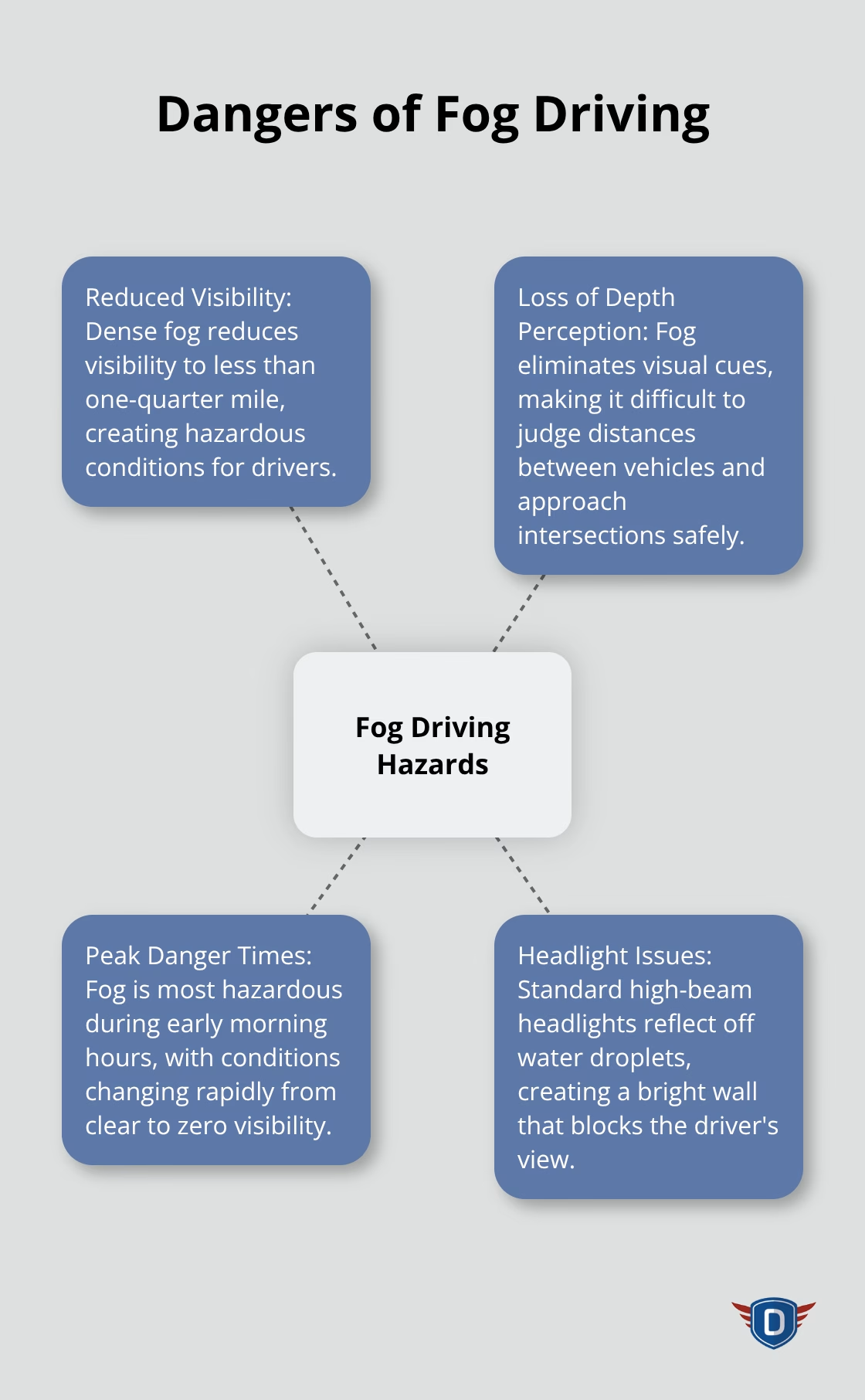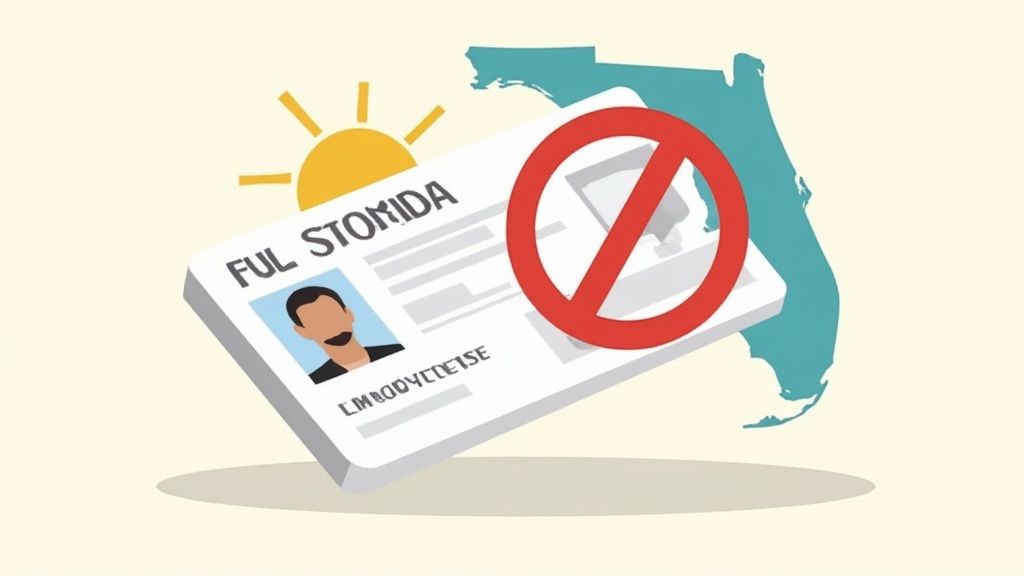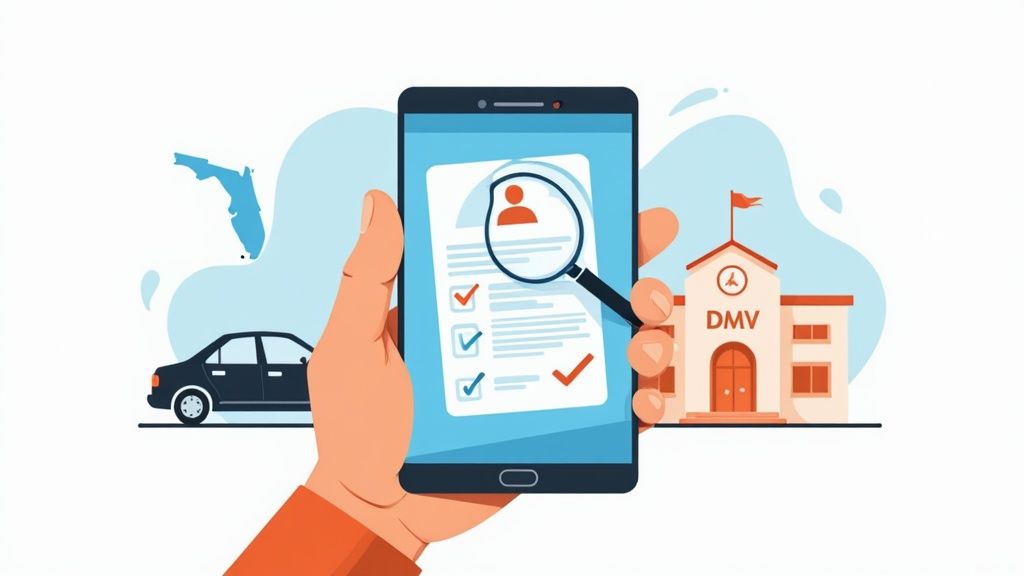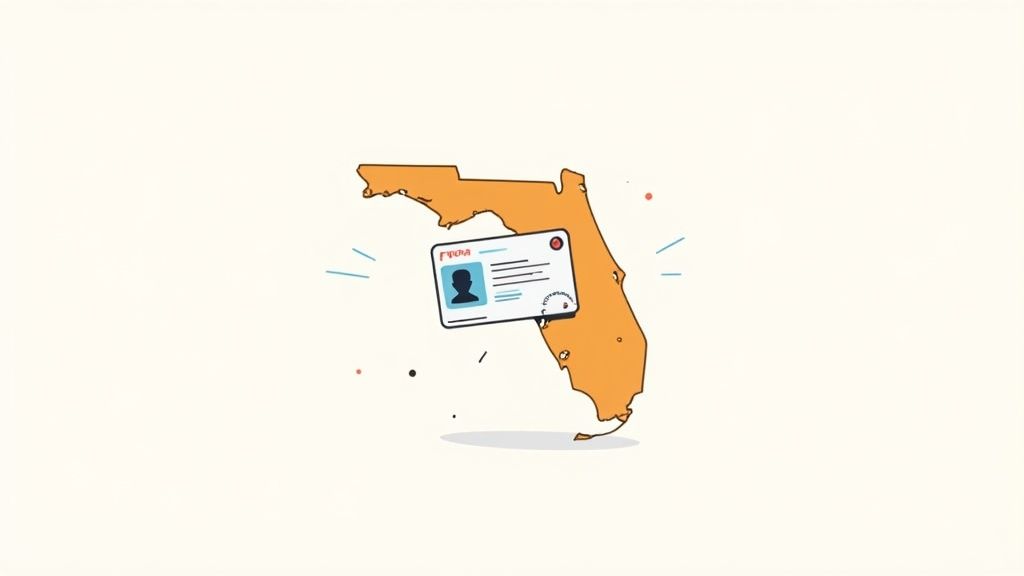Fog creates some of the most dangerous driving conditions on the road. The National Highway Traffic Safety Administration reports that weather-related crashes cause over 1.2 million accidents annually, with fog being a major contributor.
At DriverEducators.com, we know that proper preparation and safe driving tips in fog can mean the difference between arriving safely and becoming another statistic. These techniques will help you navigate low visibility conditions with confidence.
Why Fog Creates the Most Dangerous Road Conditions
Fog reduces visibility to dangerous levels and catches drivers completely unprepared. Radiation fog forms during clear, cool nights when ground temperatures drop rapidly, and typically appears in valleys and low-lying areas between midnight and sunrise. Advection fog develops when warm, moist air moves over cooler surfaces, and commonly occurs near coastlines and large bodies of water. Fog contributes to numerous travel accidents every year, creating hazardous conditions for drivers, mariners and aviators.
How Fog Destroys Your Visual Abilities
Dense fog reduces visibility to less than one-quarter mile, but the real danger lies in how it eliminates depth perception completely. Your brain relies on visual cues to judge distances between vehicles, but fog removes these reference points entirely. The droplets in fog scatter light from your headlights back toward you and create a wall of glare that makes objects appear farther away than they actually are. This optical illusion causes drivers to maintain inadequate distances and approach intersections at unsafe speeds.
Peak Danger Times You Must Know
Fog conditions can be particularly hazardous during certain times when dense fog is most likely to occur. Fog typically lifts as temperatures rise, but this process creates unpredictable visibility pockets where conditions change from clear to zero visibility within seconds.

Interstate highways experience the most severe fog crashes, with rear-end collisions that make up a significant portion of all fog-related accidents. These crashes often involve multiple vehicles because drivers cannot see stopped or slow-moving traffic ahead until impact becomes unavoidable.
Why Standard Headlights Fail in Fog
High-beam headlights create more problems than solutions in foggy conditions. The intense light reflects off water droplets and bounces back to your windshield, which creates a bright wall that blocks your view completely. Low-beam headlights penetrate fog more effectively because they aim downward and reduce glare. Fog lights (positioned lower on your vehicle) cut through fog better than standard headlights and help other drivers see your vehicle from greater distances.
Understanding these fog dangers prepares you for the specific techniques that can save your life when visibility drops to dangerous levels. Defensive driving skills teach you how to adjust your speed for conditions like thick fog, while accident prevention courses help you develop the awareness needed to navigate these challenging situations safely.
How Should You Drive When Fog Hits
Speed reduction becomes your primary survival tool when fog reduces visibility below one-quarter mile. The Texas Department of Transportation reports that most fog crashes happen because drivers maintain normal speeds despite dangerous conditions. Drop your speed to 25-35 mph on highways and 15-20 mph on local roads when visibility falls below 500 feet. Your distance to stop increases dramatically in fog because drivers must adapt to changing road surface conditions. Calculate your distance behind other vehicles with the 8-second rule instead of the standard 3-second rule – count eight full seconds between when the car ahead passes a fixed object and when you reach the same point.
Master Your Light Controls for Maximum Visibility
Low-beam headlights penetrate fog more effectively than any other standard vehicle option. High beams reflect off water droplets and create a wall of light that reduces your visibility to nearly zero. Turn on fog lights immediately when visibility drops – these lights sit lower on your vehicle and cut through fog at ground level where the air is often clearer. Keep your windshield wipers on intermittent speed and run your defroster continuously to prevent moisture buildup on glass surfaces. Clean headlights and taillights improve visibility and have a major impact on driver safety, so check them before you drive in foggy conditions.
Use Road Markings as Your Navigation System
White lane dividers and yellow center lines become your most reliable guides when fog eliminates other visual references. Focus on the right edge of the roadway rather than the center line – this technique keeps you in your lane without drift toward oncoming traffic. Reflective road markers provide critical points every 40 feet on most highways, which gives you consistent reference points to maintain proper lane position. Turn off cruise control completely because fog conditions change rapidly and require constant speed adjustments that automatic systems cannot handle safely.

These techniques work well for moderate fog conditions, but extreme visibility situations demand different strategies that can save your life when standard methods fail.
When Should You Pull Over in Fog
Zero visibility conditions require immediate action – pull over when you cannot see tail lights of vehicles directly ahead of you. The Federal Highway Administration defines dangerous fog as visibility less than 500 feet, but your personal safety threshold should be much higher. Stop when visibility drops below 1,000 feet or when you feel uncertain about your lane position. Exit the roadway completely at the next available off-ramp, rest area, or parking lot rather than stopping on highway shoulders where fog-related crashes injure or kill thousands of people each year.
Find Safe Haven Away From Traffic
Gas stations, shopping centers, and restaurant parking lots provide the safest locations during fog emergencies. The National Weather Service recommends that you get your vehicle completely off the roadway because other drivers cannot see stopped vehicles until impact becomes unavoidable. Park away from entrances where other vehicles might strike you while they maneuver in low visibility. Turn off all lights except hazard flashers after you park – brake lights and headlights confuse drivers about your vehicle status and create additional collision risks.
Emergency Protocol That Saves Lives
Activate hazard lights immediately when you decide to stop, then keep them active until fog conditions improve significantly. Set your parking brake and remove your foot from the brake pedal to prevent tail light illumination that misleads other drivers. Turn on your radio to monitor local traffic reports and weather updates that indicate when fog might lift. The Texas Department of Transportation reports that most fog clears within 2-4 hours of sunrise (making patience your most valuable safety tool during these dangerous conditions).

When to Wait vs When to Continue
Dense fog patches often create pockets of clear visibility followed by zero-visibility zones within minutes. Wait at your safe location until you can see at least 1,000 feet ahead consistently for several minutes before you resume travel. Check local weather radar on your phone to track fog movement patterns in your area. Many drivers make fatal mistakes when they attempt to push through fog that appears to be lifting but returns with even greater intensity.
Final Thoughts
Fog creates deadly conditions that claim over 600 lives annually according to the U.S. Department of Transportation. These crashes happen because drivers fail to respect how quickly visibility can drop from manageable to zero. The most effective safe driving tips in fog center on speed reduction, proper headlight use, and the 8-second following rule that gives you time to react when conditions deteriorate.
Professional training helps drivers develop the judgment needed to handle dangerous weather conditions with confidence rather than panic. We at DriverEducators.com offer driver education programs that teach students how to navigate challenging situations through practical instruction. Our courses focus on building the skills that help drivers recognize when road conditions become too hazardous to continue safely.
Smart drivers often choose not to drive when weather reports predict dense fog during their travel times. Delaying your trip until visibility improves above 500 feet protects you from conditions that can shift from clear to deadly within seconds. No meeting or deadline justifies the risk of becoming another statistic in fog-related crashes that happen every day across the country.





